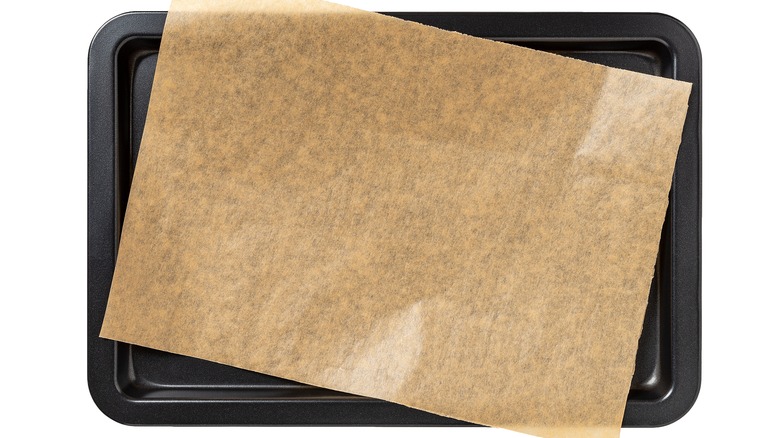The Step You Can Ignore When Baking On Parchment Paper
A well-stocked kitchen has a drawer that (at the very least) contains aluminum foil (the secret for a sparkling kitchen sink) as well as parchment paper — a baker's best friend. If you're lining a cake pan or cookie sheet with parchment paper, there's one step in the recipe you can skip: The one that tells you to grease the pan (or even the paper). This magical material is not only nonstick, but it's also heat- and grease-resistant. This comes as very good news when baking sugary things, which will want to form such a robust, caramelized bond to any non-nonstick surface that you won't be able to get them off short of sandblasting. (That's not all: Parchment paper is handy for several other baking-related jobs, too.)
Now, don't confuse parchment paper with wax paper, even though they look similar. Wax paper will not only scorch (or even catch fire) in a hot oven, its paraffin coating will transfer to your (now smoky) cookies, and "waxy" will never become a popular cookie flavor. Parchment paper, on the other hand, is food-grade, non-toxic, and treated with a release agent, typically silicone.
An acid bath and a silicone coating
In the manufacturing process, the surface of parchment paper is partially dissolved with either sulfuric acid or zinc chloride, which makes it water-resistant and ovenproof up to 428 degrees Fahrenheit. It's then coated with silicone, the non-organic substance found naturally in sand, rocks, and quartz. Silicone not only has great release effects but has a whole host of other advantageous qualities for baking, as well. It's pliable, heat-resistant, helps insulate against an unevenly heated cooking surface, won't affect the flavor of the food being baked, and doesn't contain any toxins. Best of all, you can get several uses out of a single sheet of parchment paper — which is good for you, because the stuff is expensive to make.
There's another kind of baking paper (typically used in commercial settings) that is treated with Quilon instead of silicon. Although Quilon paper is much cheaper to manufacture, Quilon can only be used once: It contains the heavy metal chromium, which breaks down under high heat and can cause health problems. The not-particularly-stable Chrome 3 complex of chemicals used in Quilon might be suspect, but they've been grandfathered in by the Food and Drug Administration. Choose unbleached parchment paper instead; heavy metal is only good for listening, not eating.
Skip the grease, improve the bake
Parchment paper's release qualities not only prevent messes and save you time, but they also might keep the bottom of your cookies from burning, too. Many people use butter or other fats when greasing a baking sheet, which can lead to burned bottoms or pooled fat. In addition, the added fat of a greased pan might be absorbed into the dough, making it spread thinner and come out flatter. Also, have you tried cleaning burned grease from a baking tray? It's decidedly not fun.
There are multiple ways to avoid this, of course: You could spring for expensive silicone liners or nonstick baking trays — or simply pick up a roll of parchment paper, tear off a pan-sized sheet, use this foolproof method for getting it to lay flat, and start cranking out the baked goods. Leave the butter in the dough, where it belongs.


